21+ Animals Like Kangaroos & Their Similarities
The Australian landscape is known for its diversity, and one of the most captivating animals found there is the kangaroo. With their unique appearance and impressive ability to hop, they have become a symbol of fascination worldwide.
Today we will share with you an amazing list of animals similar to kangaroos! Australia, known for its unique wildlife, is home to many captivating creatures resembling kangaroos in various ways. From their distinctive physical features to shared behaviors and ecological roles, these animals offer us a glimpse into the diverse tapestry of life found in the land Down Under.
In this article, we will explore more than 21 remarkable animals that exhibit similarities to kangaroos. While some may belong to the same family as kangaroos, others may share certain characteristics or adaptations that evoke a sense of familiarity.
So, let’s dive in and discover the wonders of animals like kangaroos and their similarities. Get ready to be amazed by the natural world’s ingenuity and the beauty of these captivating creatures.
Animals Like Kangaroos
Are you curious about the similarities between kangaroos and other animals? We have compiled a list of over 21 animals that share similarities with kangaroos. Take a look and discover their similarities. Have fun!
01. Wallabies
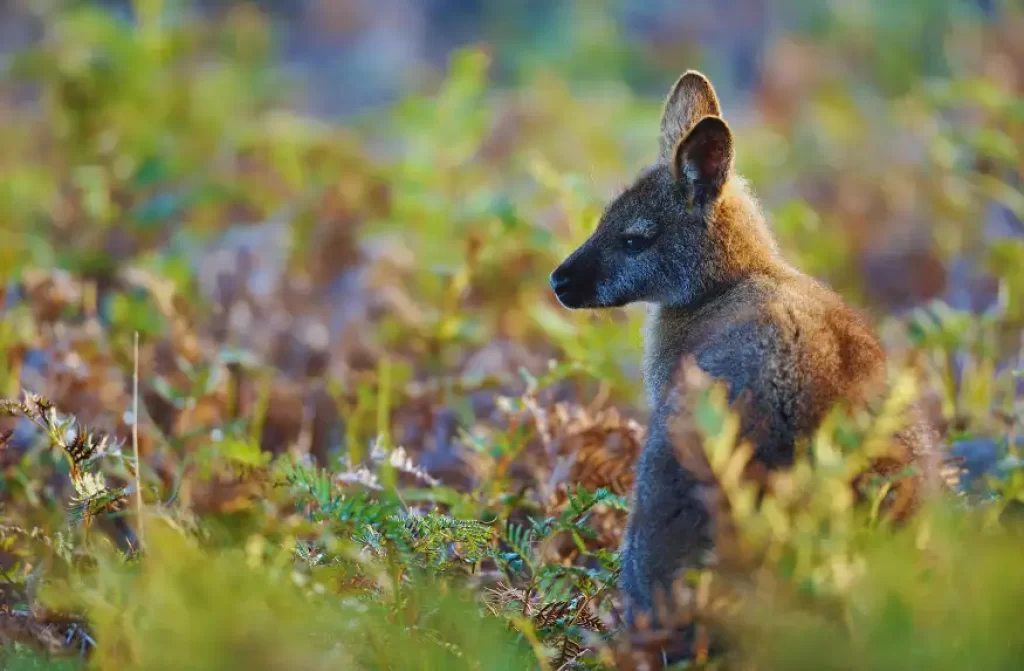
| Taxonomic Rank | Classification |
|---|---|
| Kingdom | Animalia |
| Phylum | Chordata |
| Class | Mammalia |
| Infraclass | Marsupialia |
| Order | Diprotodontia |
| Family | Macropodidae |
| Subfamily | Macropodinae |
| Genus | Macropus |
There are several species of wallabies, so I’ll list a few common ones:
- Red-necked Wallaby (Macropus rufogriseus)
- Agile Wallaby (Macropus agilis)
- Brush-tailed Rock-wallaby (Petrogale penicillata)
- Matschie’s Tree-kangaroo (Dendrolagus matschiei)
In addition to the current species listed, we will discuss more types of wallabies in this list.
Wallabies are small to medium-sized marsupials that belong to the same family as kangaroos. They share several similarities with kangaroos, both in terms of their physical characteristics and behavior. However, there are some differences between the two as well.
Like kangaroos, wallabies have powerful hind legs and long tails, which they use for balance and mobility. They are adept at hopping and can cover considerable distances with their hopping gait.
However, compared to kangaroos, wallabies are generally smaller in size, with some species reaching only a fraction of the size of their larger relatives.
Wallabies are found in various habitats, including grasslands, forests, and rocky areas. They have adapted to different environments and can thrive in a wide range of ecosystems.
Just like kangaroos, wallabies are herbivores, primarily feeding on grasses, leaves, and other vegetation. They have specialized teeth for grazing and a well-developed digestive system to extract nutrients from plant material.
In terms of behavior, wallabies, like kangaroos, are often social animals and may live in groups known as mobs.
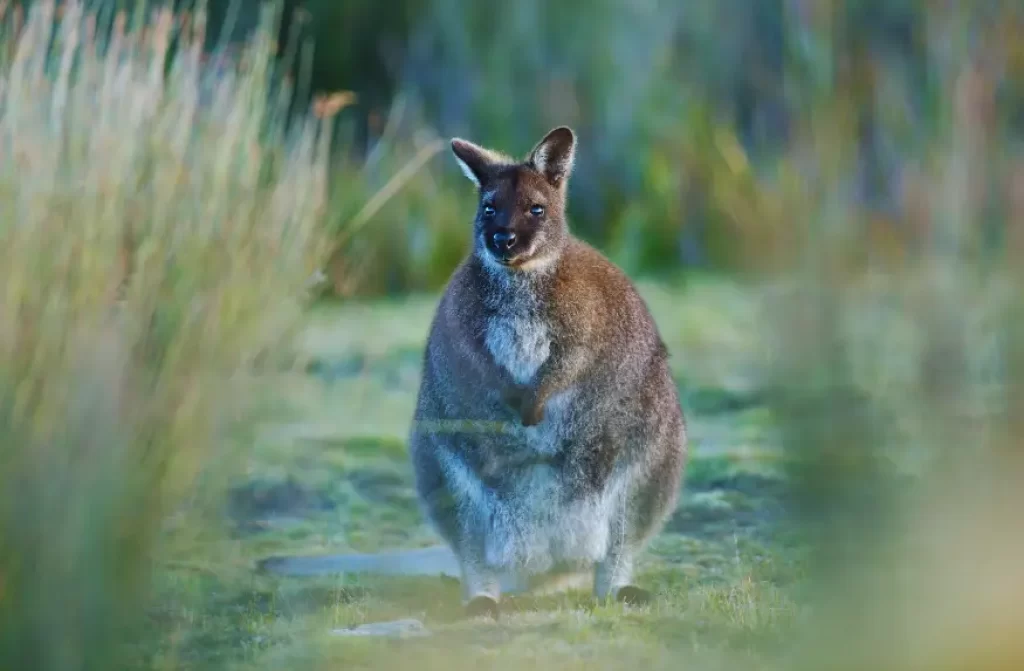
However, some species of wallabies are more solitary and prefer a more independent lifestyle. They are mostly active during the early morning and late afternoon, resting in shaded areas during the hottest parts of the day.
Wallabies, similar to kangaroos, are marsupials, meaning that females have a pouch in which they carry and nurse their young. After a short gestation period, the underdeveloped newborn, known as a joey, crawls into the pouch, where it continues to grow and develop for several months.
While wallabies and kangaroos are closely related, it is important to note that they encompass a diverse group of species with their own unique characteristics. The term “wallaby” is used to describe various species within the family Macropodidae, and their specific adaptations and behaviors can vary.
Note: Wallabies are marsupials closely related to kangaroos, sharing similarities in their physical features, feeding habits, and social behavior.
02. Bandicoots
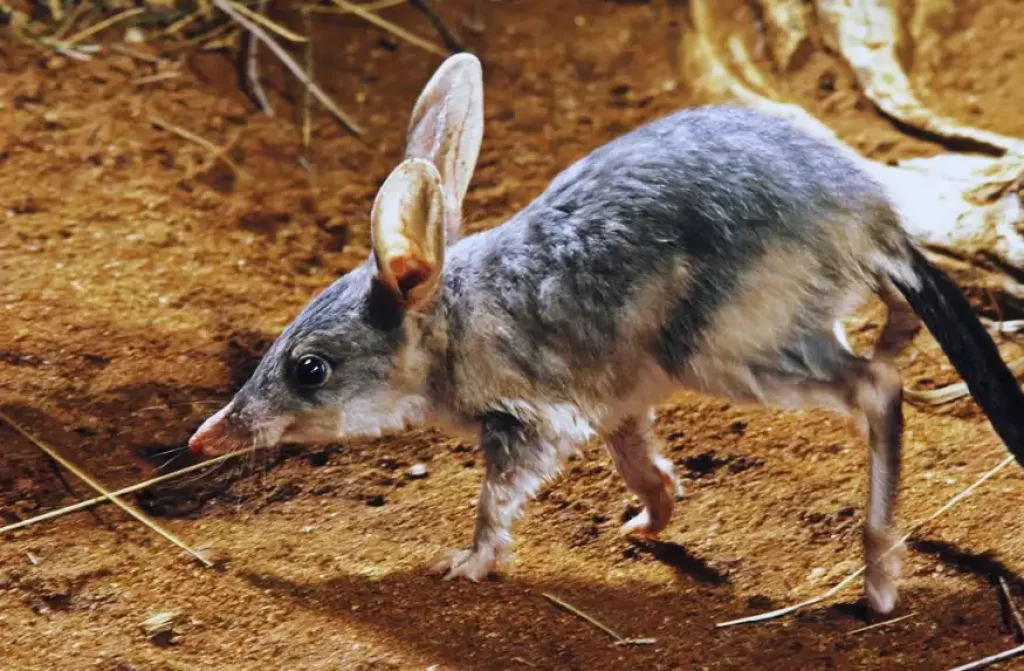
| Taxonomic Rank | Classification |
|---|---|
| Kingdom | Animalia |
| Phylum | Chordata |
| Class | Mammalia |
| Infraclass | Marsupialia |
| Order | Peramelemorphia |
| Family | Peramelidae |
| Subfamily | Peramelinae |
| Genus | Perameles |
Bandicoots are small to medium-sized marsupials with a pointy snout, known for their digging habits and omnivorous diet. They have a compact body, short legs, and strong claws that allow them to excavate burrows and forage for food. Bandicoots have a diverse diet, feeding on insects, small vertebrates, plant matter, and fungi.
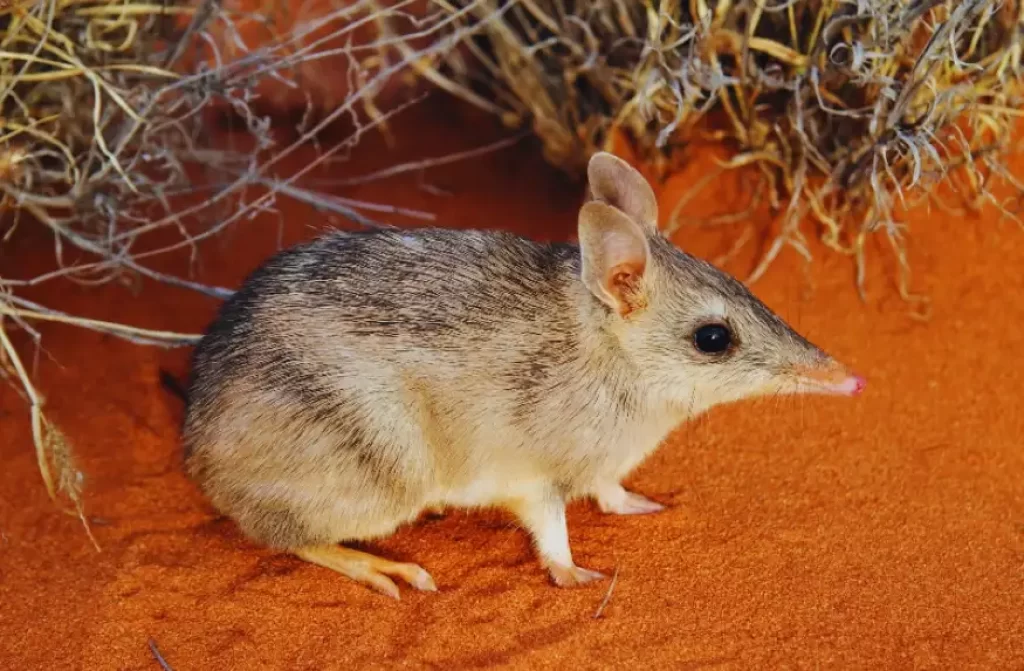
They play an important role in seed dispersal and soil aeration. Bandicoots are primarily nocturnal and have a keen sense of smell to locate food.
They are adaptable animals and can be found in various habitats, including forests, grasslands, and urban areas. However, many species of bandicoots are facing habitat loss and predation by introduced predators, which have led to declines in their populations.
03. Tasmanian Pademelons
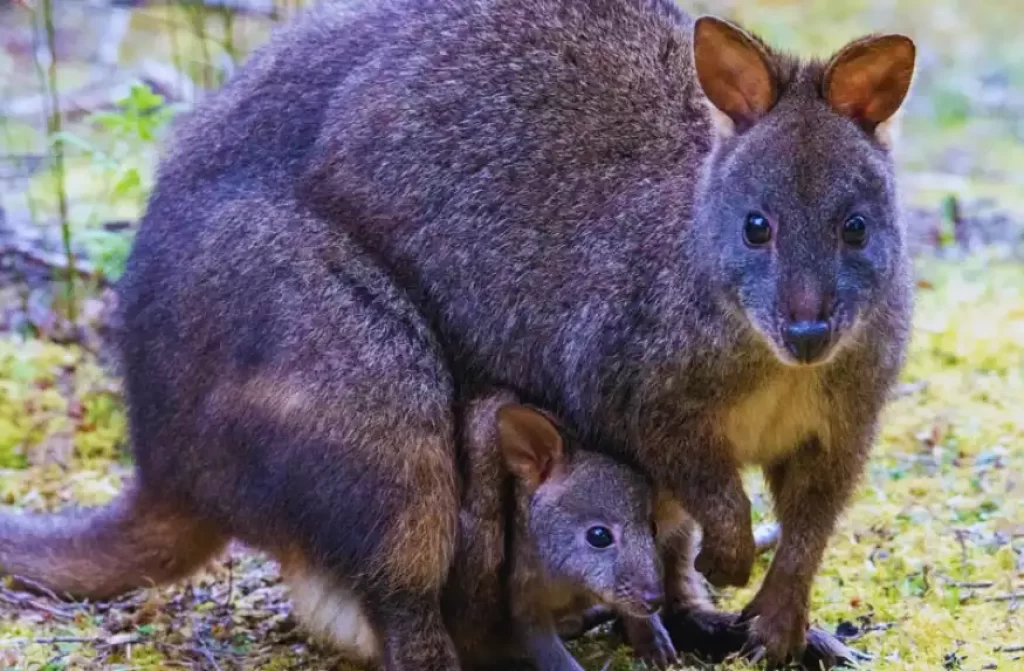
| Taxonomic Rank | Classification |
|---|---|
| Kingdom | Animalia |
| Phylum | Chordata |
| Class | Mammalia |
| Infraclass | Marsupialia |
| Order | Diprotodontia |
| Family | Macropodidae |
| Genus | Thylogale |
| Species | Thylogale billardierii |
Pademelons are small wallabies found in Tasmania, known for their compact size, short tail, and secretive nature.
They have a stocky build and dense fur, which provides insulation in the cool Tasmanian climate. Pademelons are herbivorous, feeding on a variety of plants, grasses, and fruits. They are primarily solitary animals and are most active during the early morning and late afternoon.
Pademelons have adapted to their forested habitat by using their strong hind legs to hop and navigate through dense vegetation.
They are an important part of Tasmania’s ecosystem and contribute to seed dispersal and plant pollination. However, habitat loss and fragmentation pose significant threats to their populations. Conservation efforts are in place to protect the Tasmanian pademelons and their unique habitat.
04. Sandhill Dunnarts
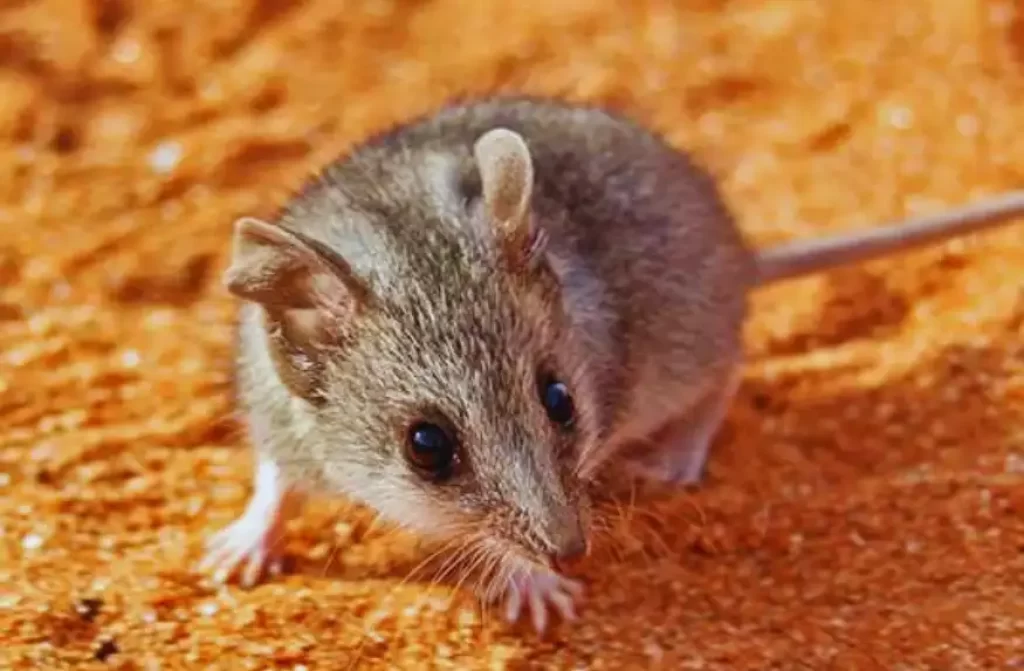
| Taxonomic Rank | Classification |
|---|---|
| Kingdom | Animalia |
| Phylum | Chordata |
| Class | Mammalia |
| Order | Dasyuromorphia |
| Family | Dasyuridae |
| Genus | Sminthopsis |
| Species | S. psammophila |
The Sandhill Dunnart (Sminthopsis psammophila) is a species of small marsupial belonging to the family Dasyuridae. With an average length of 7-10 centimeters, it is renowned for its diminutive size and elusive nature. Found in the arid regions of central and western Australia, this little creature thrives in sandy habitats such as sand dunes and shrublands.
Like kangaroos and other marsupials, the Sandhill Dunnart exhibits the captivating trait of pouch-bearing. Females possess a unique pouch where they nurture and protect their young.
While the pouch of a Dunnart faces backward, differing from the forward-facing pouch of kangaroos, the concept of sheltering their offspring within this specialized feature is a remarkable similarity shared by these marsupials.
The Sandhill Dunnart’s behavior aligns with that of kangaroos in one intriguing aspect—its nocturnal lifestyle. Just like kangaroos, this small marsupial is primarily active during the night, using its heightened senses of smell, hearing, and touch to navigate the darkness.
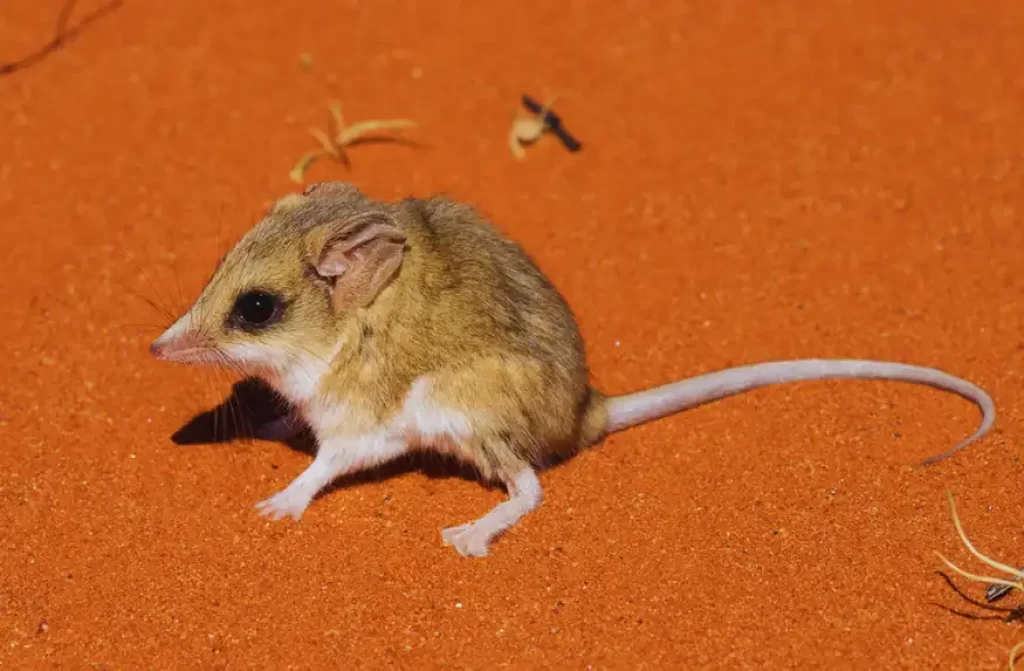
This adaptation allows it to avoid the scorching heat of the day and optimize its hunting strategies in search of prey.
While kangaroos are herbivores, the Sandhill Dunnart takes on a contrasting dietary preference. As a carnivorous marsupial, it relies on a diet consisting mainly of insects, spiders, small reptiles, and other invertebrates.
Although their diets differ, the Sandhill Dunnart’s role as a predator and its specialized adaptations for hunting are reminiscent of the diversity found within the marsupial world.
While the Sandhill Dunnart may not possess the iconic hopping abilities of kangaroos, it boasts its own remarkable adaptations.
Its small size, agile movements, and well-developed claws enable it to navigate the sandy terrain with ease, effortlessly traversing the dunes and shrublands that form its arid habitat. These agile movements reflect the adaptability and resourcefulness found in various marsupials across Australia.
06. Rock Wallabies
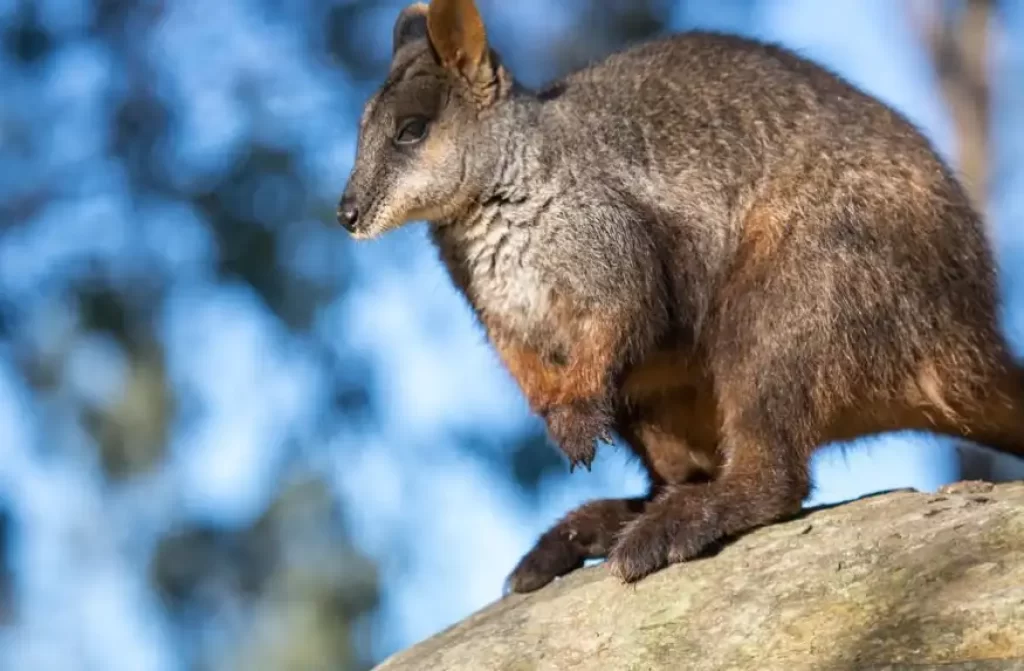
| Taxonomic Rank | Classification |
|---|---|
| Kingdom | Animalia |
| Phylum | Chordata |
| Class | Mammalia |
| Infraclass | Marsupialia |
| Order | Diprotodontia |
| Family | Macropodidae |
| Genus | Petrogale |
| Species | Varies by species |
When it comes to iconic Australian wildlife, kangaroos often steal the spotlight. However, there is another remarkable marsupial that deserves recognition for its unique traits and fascinating lifestyle—the rock wallaby. These agile creatures share common ancestry with kangaroos but have adapted to thrive in rocky habitats.
Physical Similarities
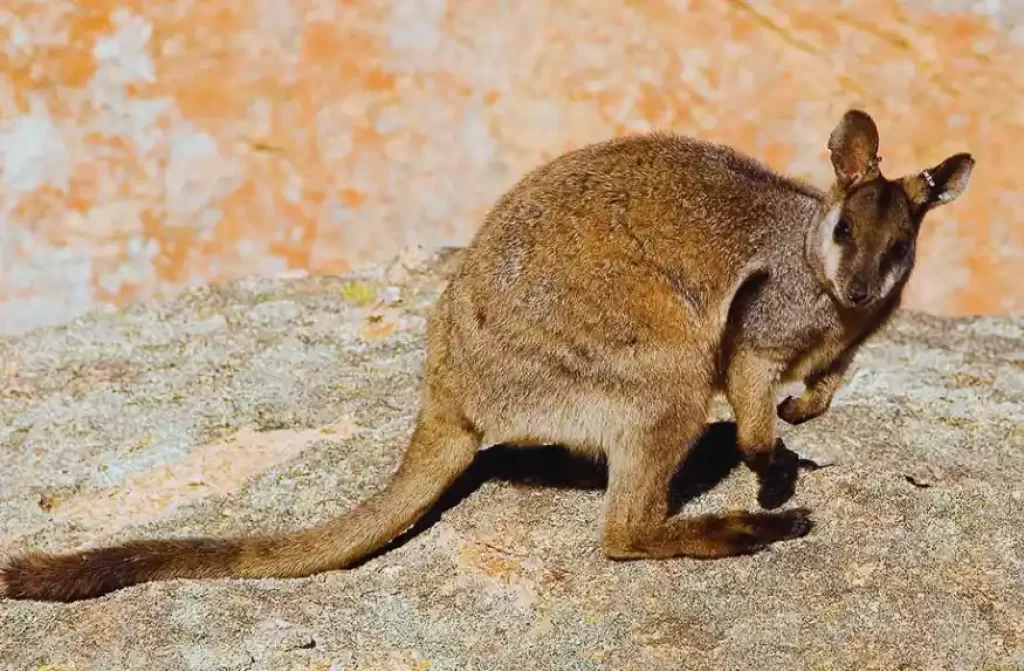
Rock wallabies, like their kangaroo relatives, belong to the macropod family, which is characterized by their large hind legs and strong tails. These distinctive features equip both species with remarkable mobility and balance, enabling them to traverse their rocky habitats with efficiency and ease.
The hind legs of kangaroos and rock wallabies are specifically designed for powerful leaps, allowing them to cover impressive distances and navigate challenging terrains effortlessly.
Size and Classification
Rock wallabies encompass a diverse array of species, resulting in variations in size depending on the specific type. On average, rock wallabies are generally smaller than kangaroos.
They possess an average body length ranging between 30 to 70 centimeters (11.8 to 27.6 inches) and a tail length of approximately 40 to 80 centimeters (15.7 to 31.5 inches). While certain species, such as the yellow-footed rock wallaby, can reach larger sizes, rock wallabies typically exhibit a smaller stature compared to kangaroos.
Habitat and Adaptations
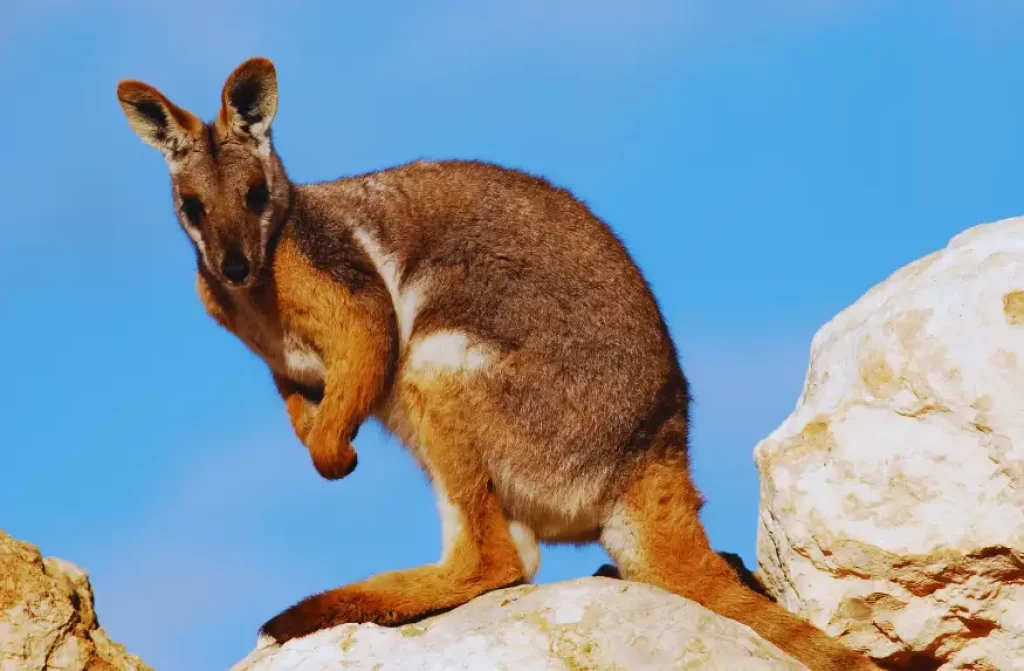
While kangaroos are well-adapted to open grasslands, rock wallabies have developed unique features to thrive in rocky environments such as cliffs, gorges, and boulder-strewn hills.
Their feet possess specialized gripping pads and strong claws that enable them to scale vertical surfaces and maintain a firm grip on rocks. These adaptations allow rock wallabies to explore and inhabit steep, rocky terrains that would be challenging for many other animals.
Behavior and Social Structure
Rock wallabies, like kangaroos, are primarily herbivorous, feeding on a variety of vegetation such as grasses, leaves, fruits, and shrubs.
However, their diet can adapt to the resources available in their specific habitats. They are generally solitary or live in small family groups, with females being the primary caregivers of their young, known as joeys.
Similar to kangaroos, rock wallabies carry their underdeveloped young in a pouch until they are sufficiently developed to venture out.
07. Patagonian Mara
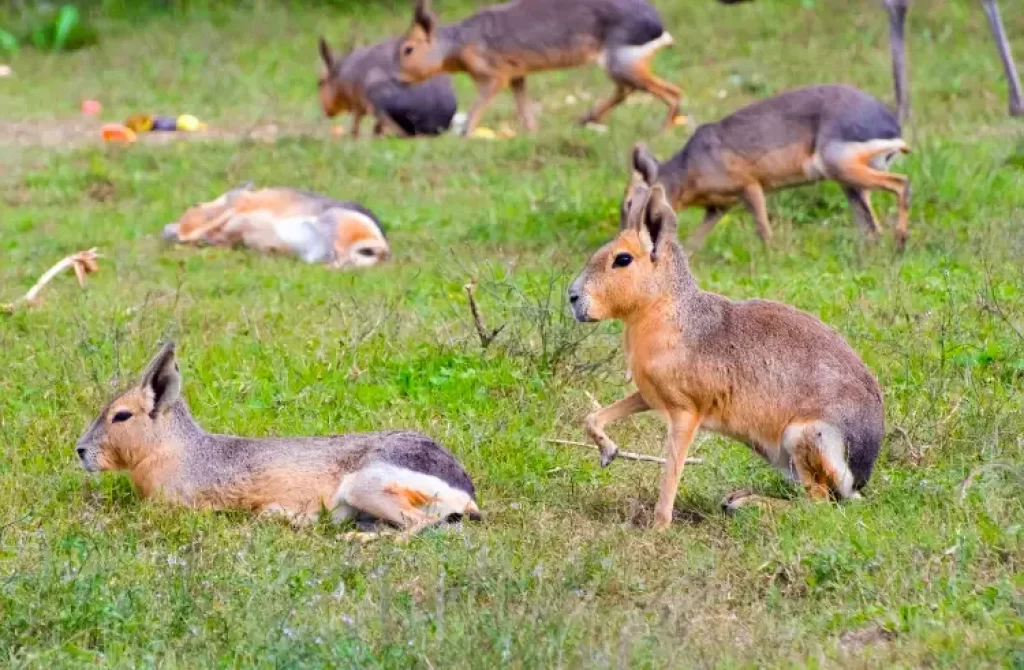
| Taxonomic Rank | Classification |
|---|---|
| Kingdom | Animalia |
| Phylum | Chordata |
| Class | Mammalia |
| Order | Rodentia |
| Family | Caviidae |
| Genus | Dolichotis |
| Species | Dolichotis patagonum |
The Patagonian Mara, also known as the Patagonian cavy or dillaby, is a unique and charismatic animal that shares some similarities with kangaroos, making it an interesting addition to the list of animals like kangaroos. Although not closely related to kangaroos, the Patagonian Mara belongs to the same taxonomic family as guinea pigs and capybaras.
The Patagonian Mara is native to the grasslands and scrublands of Argentina and parts of Chile. It is a medium-sized herbivorous mammal with a slender body and long limbs, which resemble those of kangaroos in terms of their elongation and agility.
Like kangaroos, the Patagonian Mara has powerful hind legs that enable it to move quickly and efficiently across its habitat.
One of the notable features of the Patagonian Mara is its ability to hop, although it lacks the exaggerated hopping behavior seen in kangaroos. Instead, it uses a combination of hopping and running to navigate its environment. This unique form of locomotion allows the Patagonian Mara to escape from predators and cover large distances when foraging for food.
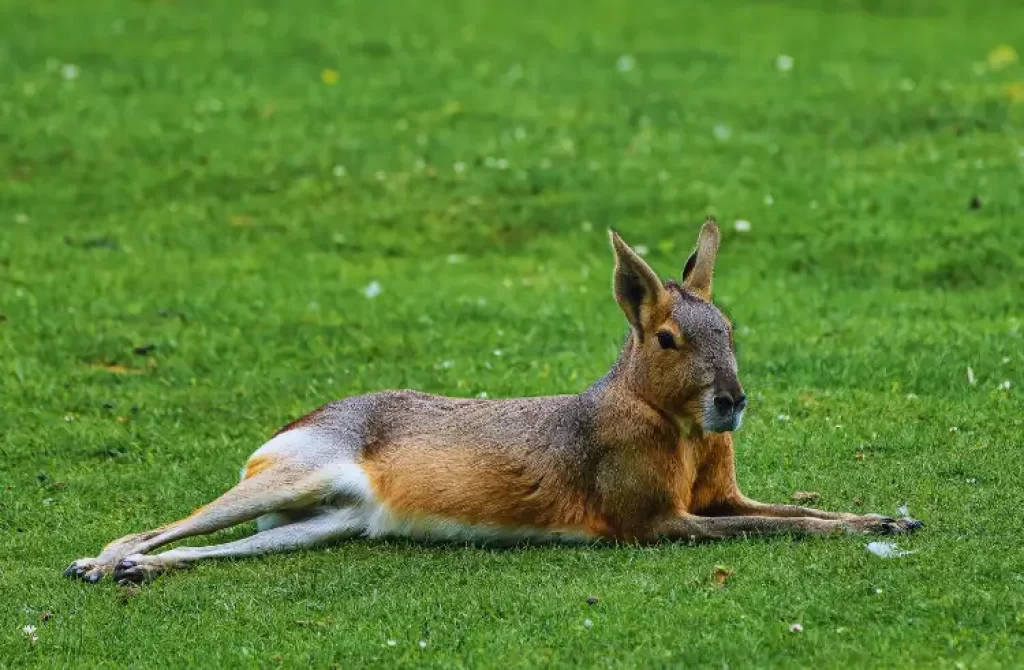
The Patagonian Mara is a social animal and typically lives in small groups consisting of a monogamous breeding pair and their offspring. They construct complex burrow systems for shelter, which provide protection from extreme temperatures and potential predators.
In terms of diet, the Patagonian Mara is primarily herbivorous, feeding on grasses, herbs, and other vegetation. Its long limbs and well-developed senses help it efficiently locate and consume plant matter.
While the Patagonian Mara may not be closely related to kangaroos, its similar physical characteristics, including long limbs, hopping locomotion, and herbivorous diet, make it an interesting parallel to kangaroos when discussing animals with comparable traits.
08. Potoroos
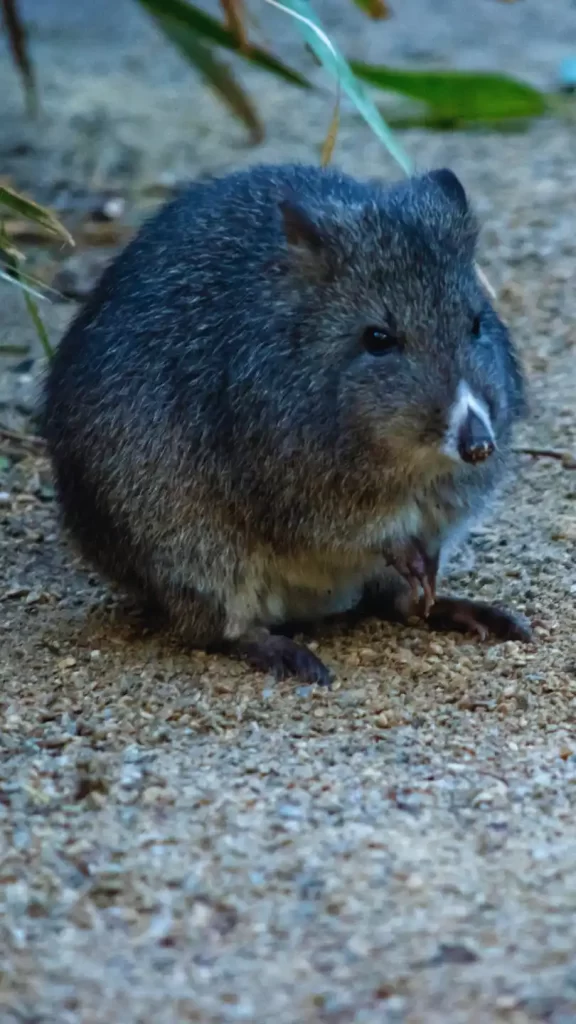
| Taxonomic Rank | Classification |
|---|---|
| Kingdom | Animalia |
| Phylum | Chordata |
| Class | Mammalia |
| Order | Diprotodontia |
| Family | Potoroidae |
| Genus | Potorous |
| Species | Various species |
Potoroos are small marsupials that share similarities with both kangaroos and bandicoots. They possess a compact body, short tail, and strong hind legs, which enable them to navigate their environment effectively.
Potoroos are primarily nocturnal creatures, active during the night when they venture out in search of food. They have specialized digging abilities, utilizing their long claws to excavate the soil in search of tubers, fungi, and plant roots.
This adaptation allows them to access hidden food sources and thrive in their habitat. Potoroos showcase the diversity within the marsupial family and highlight the unique features and behaviors that have evolved in response to their specific ecological niche.
09. Bilbies
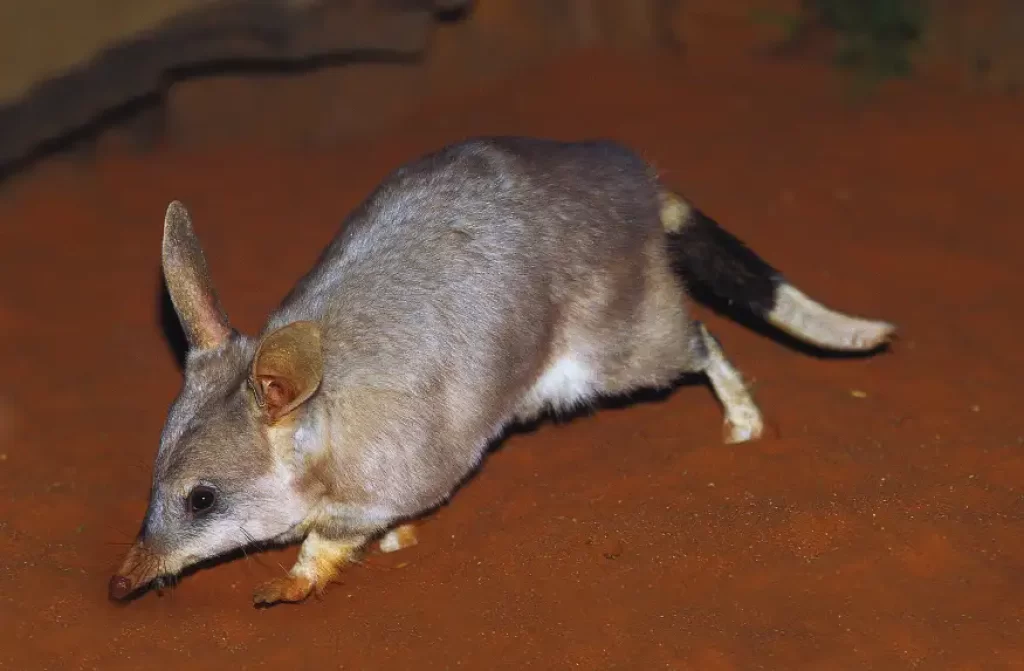
| Taxonomic Rank | Classification |
|---|---|
| Kingdom | Animalia |
| Phylum | Chordata |
| Class | Mammalia |
| Order | Peramelemorphia |
| Family | Thylacomyidae |
| Genus | Macrotis |
| Species | Various species |
Bilbies are small to medium-sized marsupials that are often likened to kangaroos due to their unique appearance and some shared characteristics. These nocturnal creatures are native to Australia, specifically the arid and semi-arid regions, where they inhabit sandy desert areas.
One notable similarity between bilbies and kangaroos is their marsupial nature. Like kangaroos, female bilbies have a pouch in which they carry and nurse their young, known as joeys.
The pouch is located on the lower abdomen and opens backward to protect the young ones from sand and other debris.
In terms of physical characteristics, bilbies have a slender body, long ears, and a pointed snout. Their large ears serve a practical purpose, enabling them to detect sounds and movements in their environment.
Bilbies also possess strong forelimbs and sharp claws, which they use for digging burrows in the sandy soil. These burrows provide shelter from the harsh desert conditions and protection against predators.
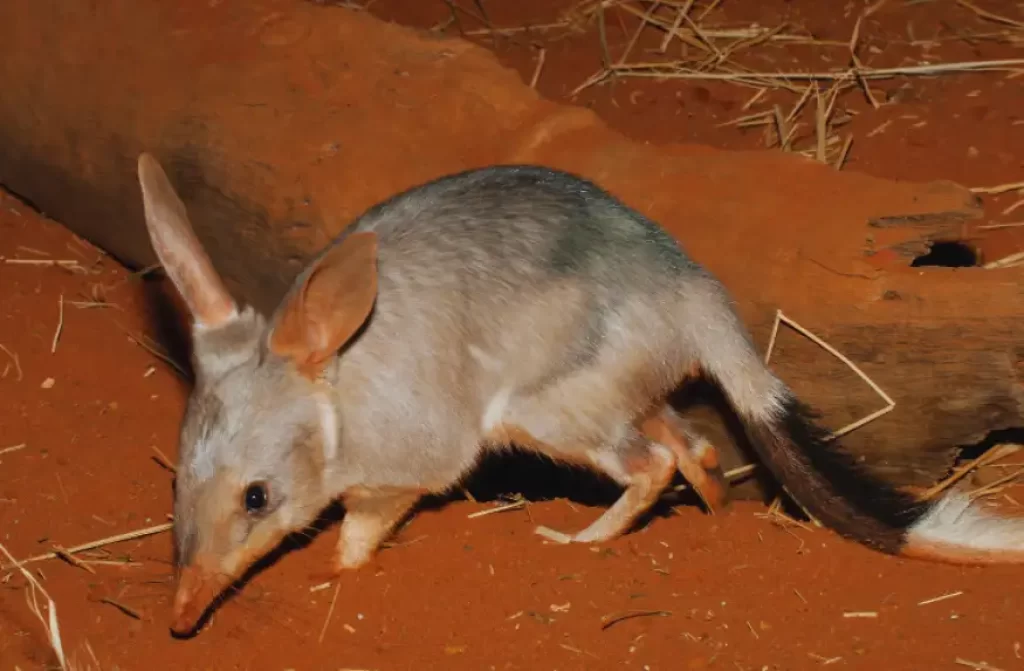
Another shared trait with kangaroos is their diet. Bilbies are omnivorous, feeding on a varied range of food including insects, seeds, bulbs, fruit, and fungi.
They have a long tongue that helps them forage for their preferred food items, such as termites and other small invertebrates.
Bilbies, like kangaroos, play an important role in their ecosystem. They help disperse seeds through their feeding habits and contribute to soil aeration through their digging activities. Unfortunately, bilbies have faced significant population decline due to habitat loss, predation by introduced species, and competition for resources. Conservation efforts are in place to protect and restore their populations.
Note: Bilbies share some similarities with kangaroos, including their marsupial nature, specialized adaptations, and ecological roles.
10. Quokkas

| Taxonomic Rank | Classification |
|---|---|
| Kingdom | Animalia |
| Phylum | Chordata |
| Class | Mammalia |
| Order | Diprotodontia |
| Family | Macropodidae |
| Genus | Setonix |
| Species | S. brachyurus |
Quokkas are charming marsupials often referred to as the “happiest animal on Earth.” Residing mainly on Rottnest Island in Western Australia, they have gained popularity due to their friendly and curious nature, earning them the title of “the smiling marsupial.”
Quokkas have a compact body, short tail, and a facial expression that appears to be eternally smiling. They primarily feed on grasses, leaves, and stems, and their presence on the island contributes to the ecosystem’s biodiversity.
The Quokka Selfie Phenomenon
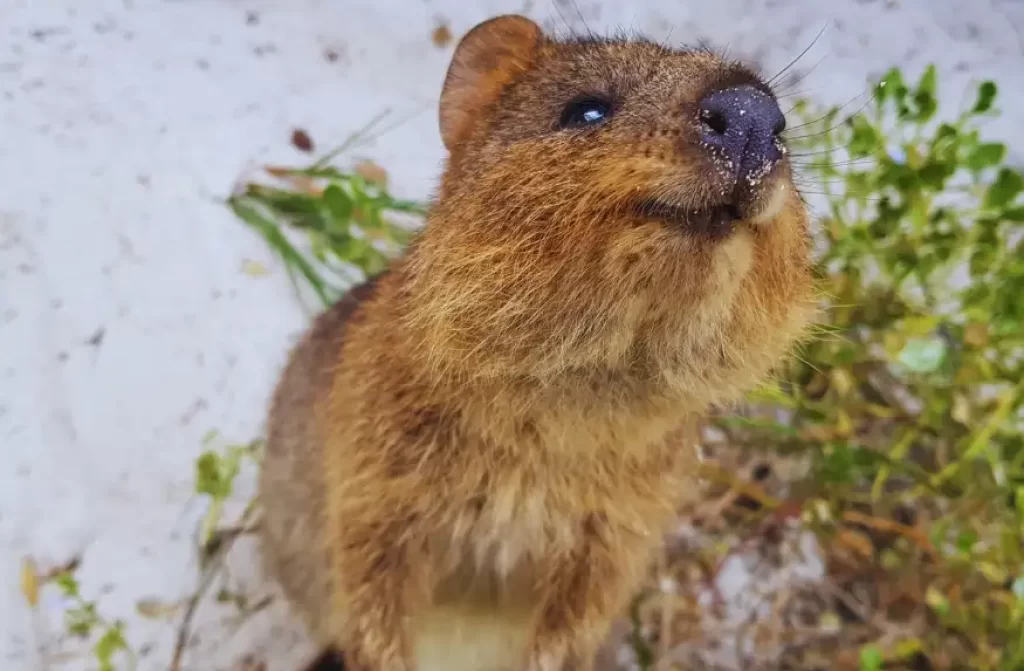
In recent years, quokkas have gained significant popularity due to the rise of “quokka selfies.” Visitors to Rottnest Island often take photos with quokkas, capturing their happy expressions.
It is important to remember that while capturing memorable moments is enjoyable, it should never come at the expense of the animal’s welfare. Respecting their natural behavior and environment is vital to ensure their continued well-being.
11. Pademelons
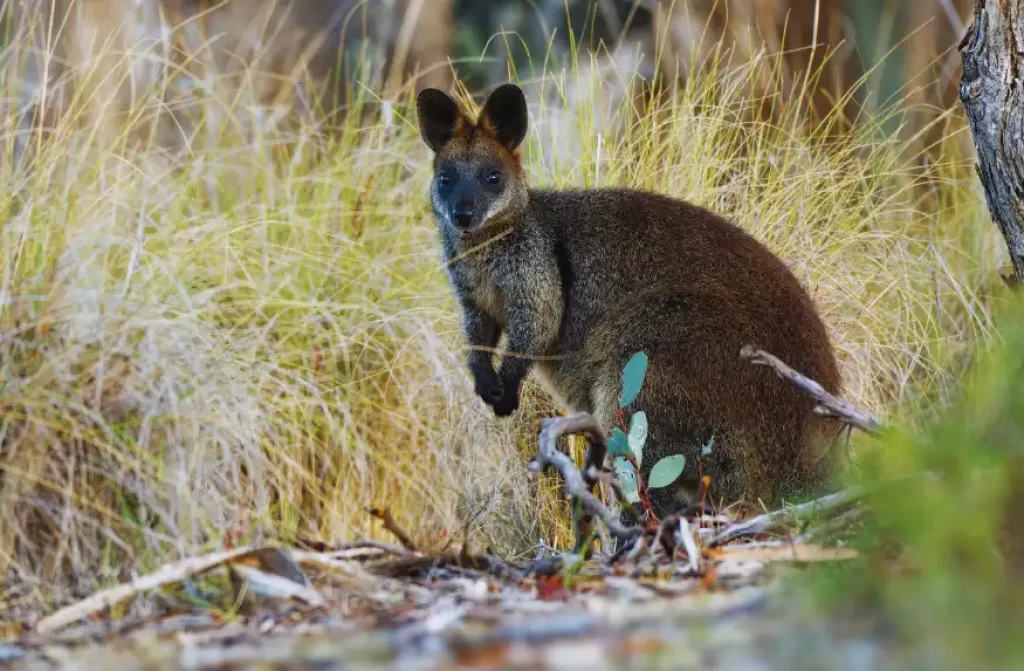
| Taxonomic Rank | Classification |
|---|---|
| Kingdom | Animalia |
| Phylum | Chordata |
| Class | Mammalia |
| Order | Diprotodontia |
| Family | Macropodidae |
| Genus | Thylogale |
| Species | Various species |
Pademelons are small to medium-sized marsupials that belong to the same family as kangaroos and wallabies, making them fascinating creatures to include in the list of animals like kangaroos.
They are native to Australia and New Guinea, inhabiting a variety of habitats, including rainforests, woodlands, and grasslands.
Similar to kangaroos, pademelons have a compact body with powerful hind legs, which allow them to move swiftly and efficiently.
However, they are smaller in size compared to kangaroos and wallabies, typically ranging from 40 to 70 centimeters in length.
One of the distinctive features of pademelons is their short tail, which differentiates them from their close relatives.
This short tail gives them a more rounded appearance. Like kangaroos, pademelons are herbivorous and primarily feed on grasses, leaves, and other plant material. They have specialized teeth adapted for grazing, allowing them to efficiently consume vegetation.
Pademelons are generally solitary animals, although they may come together in small groups or pairs for social interactions or mating. They are mainly active during the early morning and late afternoon, spending the hottest parts of the day resting in shaded areas.
These marsupials are agile and nimble, capable of jumping and bounding through their environment. They use their strong hind legs to propel themselves forward and escape from predators.
When threatened, pademelons may also take cover in dense vegetation or rely on their ability to swiftly change direction to evade danger.
Overall, pademelons exhibit many physical and behavioral characteristics that resemble their kangaroo relatives.
Their compact size, powerful hind legs, herbivorous diet, and agile movements make them an interesting addition to the list of animals similar to kangaroos. Studying pademelons provides insights into the diversity of marsupials and their unique adaptations in different ecosystems.
13. Bettongs
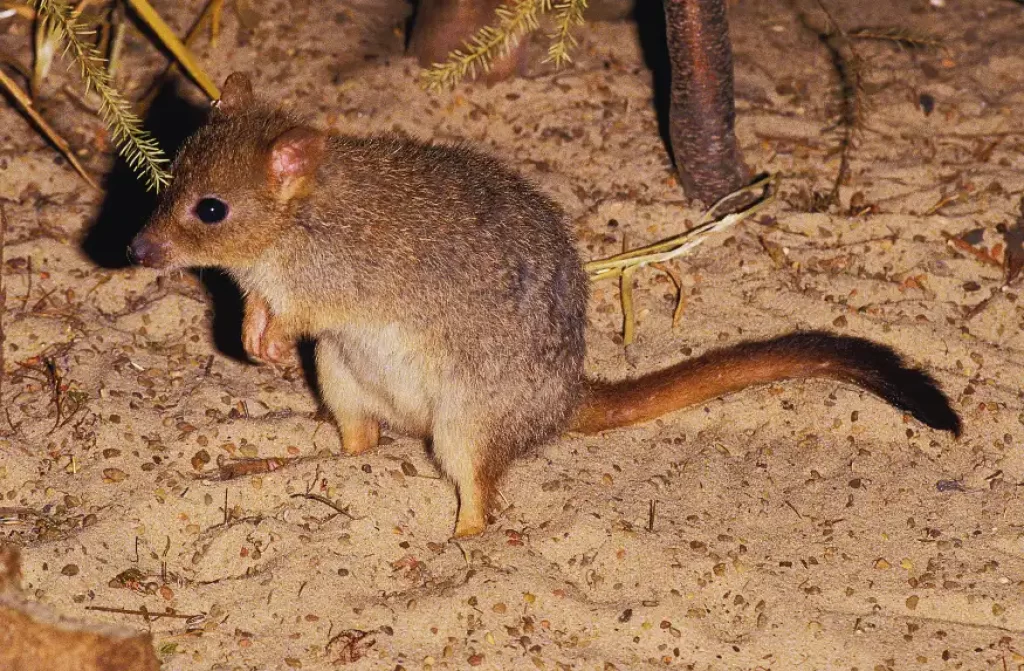
| Taxonomic Rank | Classification |
|---|---|
| Kingdom | Animalia |
| Phylum | Chordata |
| Class | Mammalia |
| Order | Diprotodontia |
| Family | Potoroidae |
| Genus | Bettongia |
| Species | Various species |
Bettongs are small marsupials that bear a resemblance to rabbits, earning them the nickname “rabbit-rats.” They possess a slender body, long tail, and powerful hind legs that enable them to move swiftly through their grassland and forest habitats.
Bettongs primarily feed on roots, tubers, and fungi, playing a crucial role in soil aeration and seed dispersal. These agile creatures contribute to the health and diversity of their ecosystems and are known for their unique digging behavior.
14. Kangaroo Rats
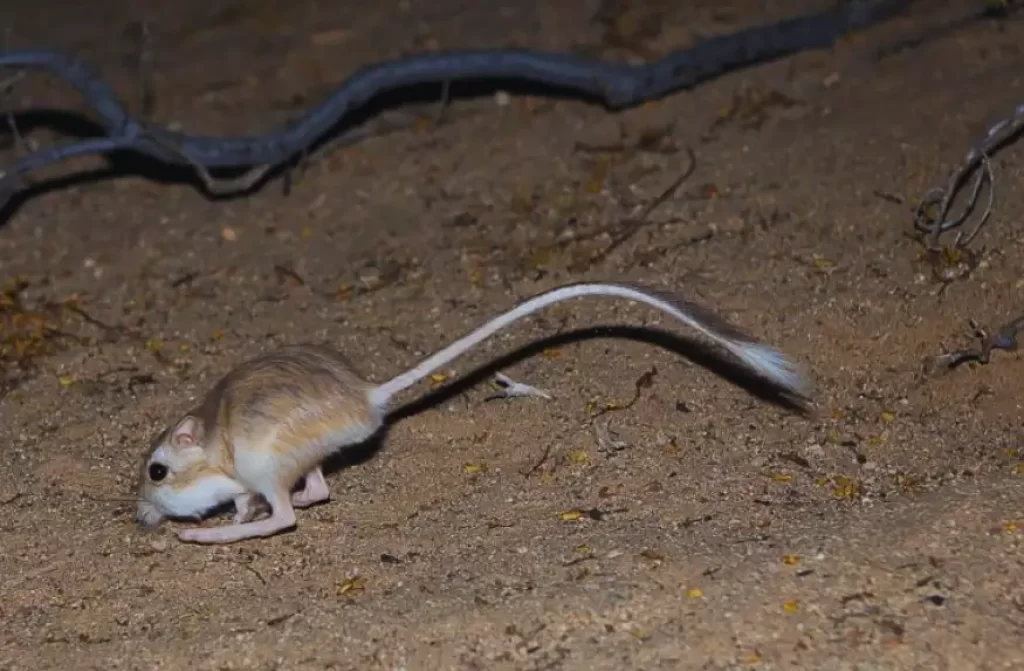
| Taxonomic Rank | Classification |
|---|---|
| Kingdom | Animalia |
| Phylum | Chordata |
| Class | Mammalia |
| Order | Rodentia |
| Family | Heteromyidae |
| Genus | Dipodomys |
| Species | Various species |
Kangaroo rats are small rodents known for their kangaroo-like hopping behavior. They have large hind legs and a long tail, which they utilize for balance and propulsion.
Kangaroo rats are predominantly found in arid regions, where they have developed remarkable adaptations to survive in desert environments.
These adaptations include specialized kidneys that conserve water and enable them to thrive in extremely dry conditions.
Kangaroo rats have a diverse diet, feeding on seeds, vegetation, and occasionally insects. Their unique adaptations make them well-suited to their desert habitats and showcase the incredible resilience of desert-dwelling animals.
15. Spring Hare
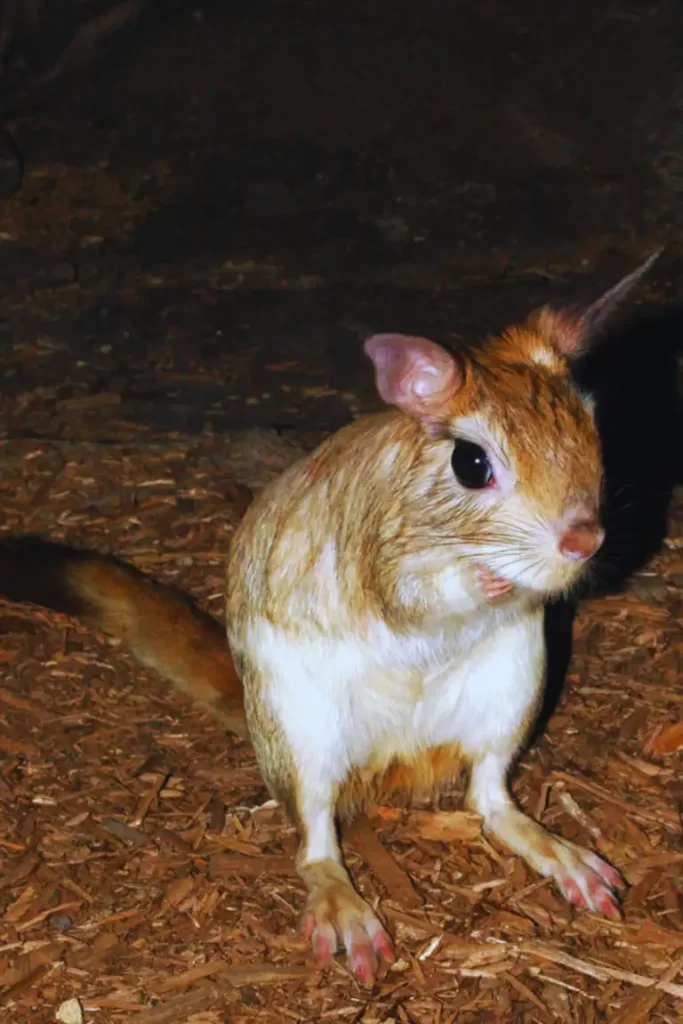
| Taxonomic Rank | Classification |
|---|---|
| Kingdom | Animalia |
| Phylum | Chordata |
| Class | Mammalia |
| Order | Lagomorpha |
| Family | Pedetidae |
| Genus | Pedetes |
| Species | Various species |
The Spring Hare, also known as the Springhaas or Springhare, is a unique and fascinating animal that shares some similarities with kangaroos, making it an interesting addition to the list of animals like kangaroos.
However, it is important to note that the Spring Hare is not closely related to kangaroos and belongs to a different taxonomic family.
The Spring Hare is a species of rodent found in parts of southern Africa, particularly in the arid and semi-arid regions.
It is known for its remarkable jumping ability, which is reminiscent of kangaroos’ hopping behavior. Just like kangaroos, the Spring Hare has long and powerful hind limbs that allow it to make incredible leaps when moving across its habitat.
One of the key adaptations of the Spring Hare is its elongated hind limbs, which are specially designed for efficient jumping.
These limbs, combined with a long and muscular tail, provide balance and propulsion during leaps. This unique locomotion allows the Spring Hare to swiftly navigate its environment and evade potential predators.
The Spring Hare is also a nocturnal creature, primarily active during the night. It has a compact body, covered in dense fur, which provides insulation and protection from the harsh desert climate. Its large ears are another characteristic feature that helps it detect sounds and potential threats in its surroundings.
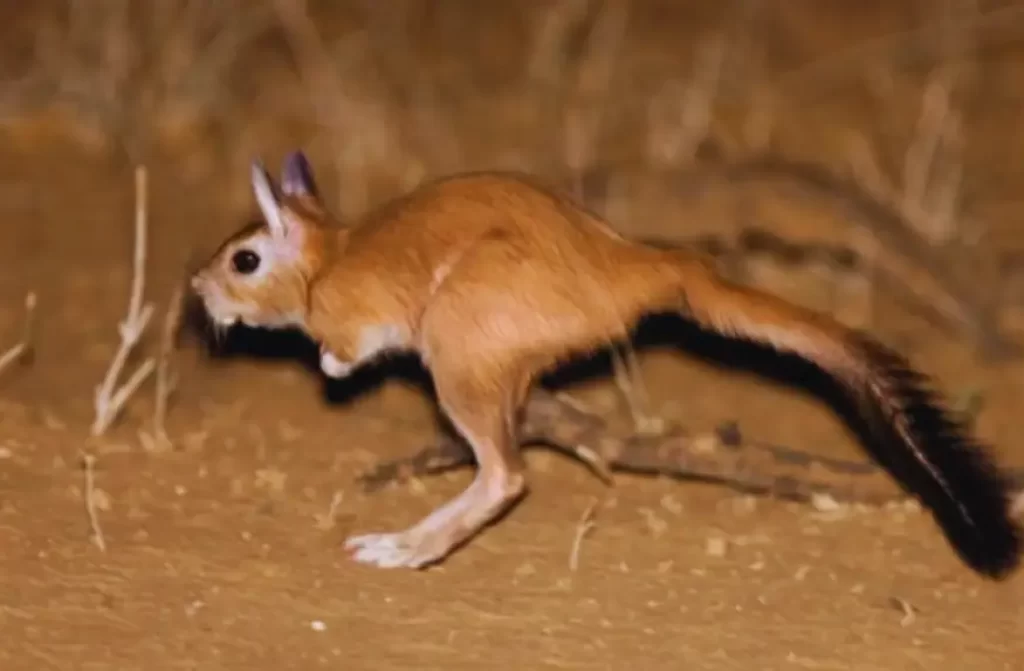
In terms of diet, the Spring Hare is herbivorous, feeding on a variety of plant materials such as grasses, leaves, and roots. This puts it in contrast to kangaroos, which are primarily herbivores but mainly feed on different types of vegetation, such as grasses, shrubs, and even tree leaves.
While the Spring Hare shares some physical similarities with kangaroos, such as powerful hind limbs and hopping locomotion, it is important to recognize that they belong to separate evolutionary lineages.
Nonetheless, highlighting the Spring Hare in a discussion about animals like kangaroos can provide a broader perspective on the diversity of adaptations and locomotion strategies observed in the animal kingdom.
16. Tree Wallabies
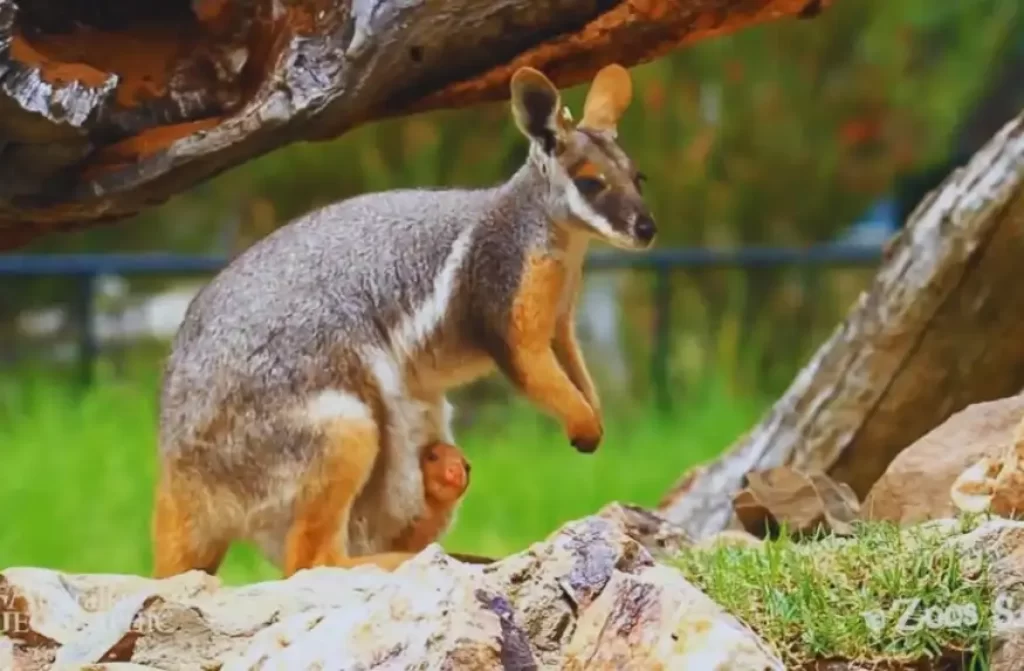
| Taxonomic Rank | Classification |
|---|---|
| Kingdom | Animalia |
| Phylum | Chordata |
| Class | Mammalia |
| Order | Diprotodontia |
| Family | Macropodidae |
| Subfamily | Macropodinae |
| Genus | Dendrolagus |
| Species | Various species |
Tree wallabies are remarkable marsupials that have successfully adapted to life in trees. They exhibit a slender body, long tail, and powerful hind legs, which allow them to navigate their arboreal habitats with grace.
These agile climbers are primarily found in tropical rainforests, where they can leap from tree to tree using their muscular hind limbs.
Tree wallabies have a varied diet, feeding on leaves, fruits, and even bark. Their arboreal lifestyle and specialized adaptations make them well-suited to their forested environments, demonstrating the remarkable diversity of marsupials in Australia.
These animals, like kangaroos, represent the unique and diverse wildlife found in Australia and its surrounding regions. Each species has its own fascinating characteristics and plays a crucial role in their respective ecosystems.
17. Wallaroos
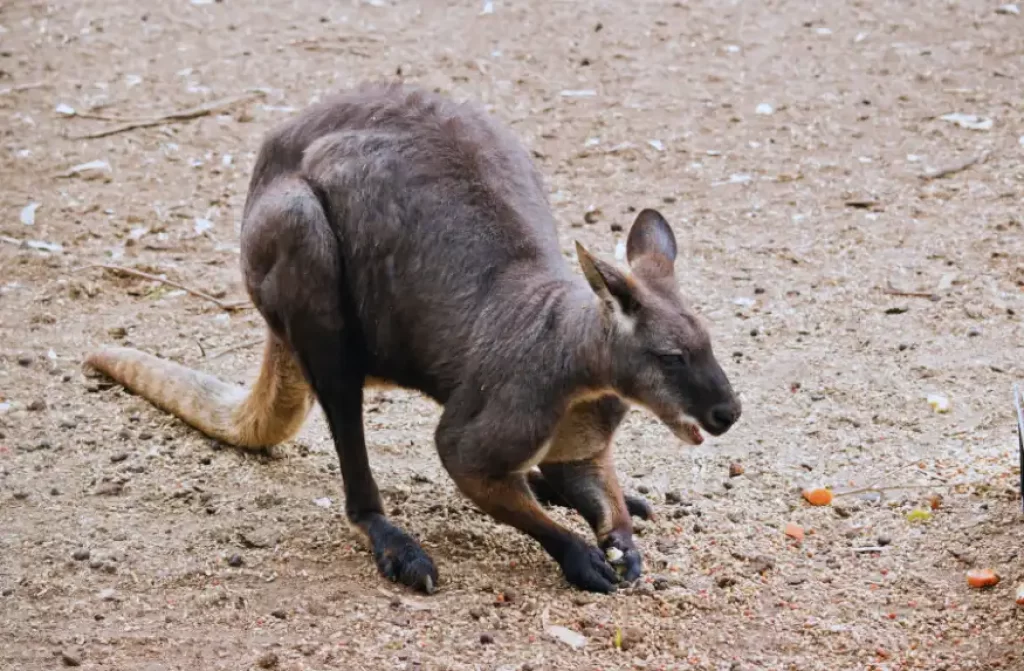
| Taxonomic Rank | Classification |
|---|---|
| Kingdom | Animalia |
| Phylum | Chordata |
| Class | Mammalia |
| Order | Diprotodontia |
| Family | Macropodidae |
| Genus | Macropus |
| Species | Various species |
Wallaroos are large marsupials that share a close resemblance to kangaroos. They belong to the same family as kangaroos and share similar physical features, such as powerful hind legs, a long tail, and a pouch. However, wallaroos are generally smaller in size compared to kangaroos, with some species reaching a height of about 3 to 5 feet.
These robust creatures are known for their impressive hopping ability, allowing them to traverse various terrains with agility. Wallaroos can be found in a range of habitats, including grasslands, rocky areas, and open woodlands. Their strong legs and sturdy build enable them to navigate these diverse landscapes effectively.
Wallaroos have adapted to survive in harsh environments and are well-suited for arid and semi-arid regions. They have a herbivorous diet, primarily feeding on grasses, shrubs, and other vegetation. With their unique physical characteristics and adaptability, wallaroos contribute to the rich biodiversity of Australian marsupials.
18. Tree Kangaroos
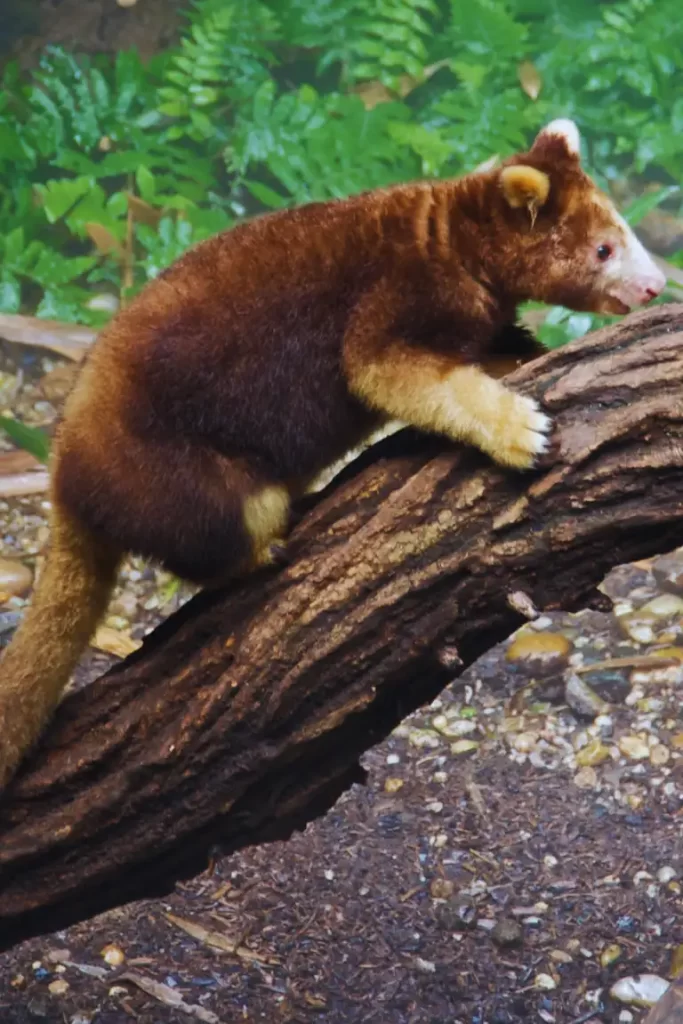
| Taxonomic Rank | Classification |
|---|---|
| Kingdom | Animalia |
| Phylum | Chordata |
| Class | Mammalia |
| Order | Diprotodontia |
| Family | Macropodidae |
| Genus | Dendrolagus |
| Species | Various species |
Tree kangaroos are unique marsupials that have adapted to life in the trees. They share similarities with ground-dwelling kangaroos but have several distinct features that enable them to navigate the arboreal environment. These fascinating creatures are found in the rainforests of Australia and New Guinea.
Tree kangaroos have strong forelimbs and long tails, which provide balance and support as they move through the branches. Their powerful hind legs allow them to make impressive leaps from tree to tree. Unlike their terrestrial counterparts, tree kangaroos have shorter and broader hind feet with gripping pads that aid in climbing.
These marsupials have a varied diet, consisting of leaves, fruits, and tree bark. They are specially adapted to digest the toxic compounds found in many rainforest plants. Tree kangaroos also have a unique reproductive system, with females having a pouch to carry and nurture their young.
Due to their specialized habitat requirements and limited distribution, tree kangaroos are considered threatened species. Conservation efforts are in place to protect their rainforest habitats and ensure their long-term survival in the wild.
You might also find interesting: 15 Animals That Can Match or Challenge a Kangaroo
19. Musky Rat-Kangaroo
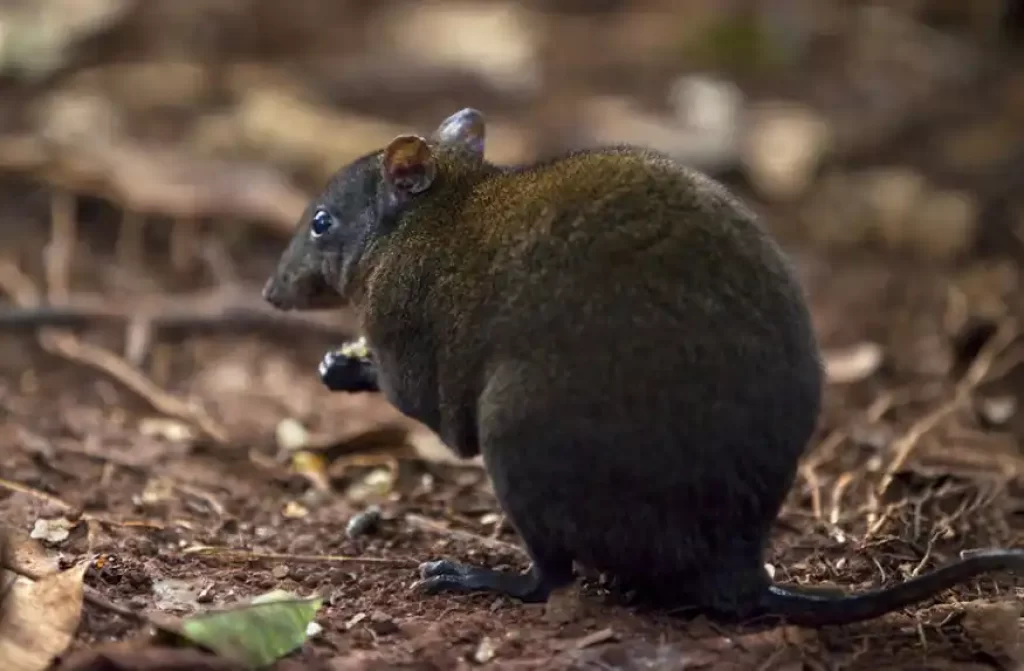
| Taxonomic Rank | Classification |
|---|---|
| Kingdom | Animalia |
| Phylum | Chordata |
| Class | Mammalia |
| Order | Diprotodontia |
| Family | Hypsiprymnodontidae |
| Genus | Hypsiprymnodon |
| Species | H. moschatus |
The Musky Rat-Kangaroo, also known as the Musky Rat Wallaby, is a small marsupial found in the rainforests of northeastern Australia and New Guinea. Despite its name, the Musky Rat-Kangaroo is not closely related to true rats or kangaroos, but it belongs to a distinct family of marsupials called Hypsiprymnodontidae.
The Musky Rat-Kangaroo has a unique and primitive appearance. It has a stocky body with short limbs, a long and furry tail, and a pointed snout. Its fur is dark brown or black, providing excellent camouflage in the dense rainforest undergrowth.
Unlike other kangaroos, the Musky Rat-Kangaroo is primarily terrestrial and does not hop. It moves with a quadrupedal gait, using its strong hind limbs and long claws for digging and climbing. This small marsupial is primarily active at night and spends its days hidden in vegetation or in burrows.
The diet of the Musky Rat-Kangaroo consists mainly of fallen fruits, seeds, and fungi. It plays an important role in seed dispersal within the rainforest ecosystem. The female Musky Rat-Kangaroo has a backward-opening pouch, where it carries and nurses its young.
Due to habitat loss and fragmentation, the Musky Rat-Kangaroo is considered vulnerable to extinction. Conservation efforts focus on protecting its rainforest habitat and raising awareness about the importance of preserving this unique and ancient marsupial species.
20. Common Wombats
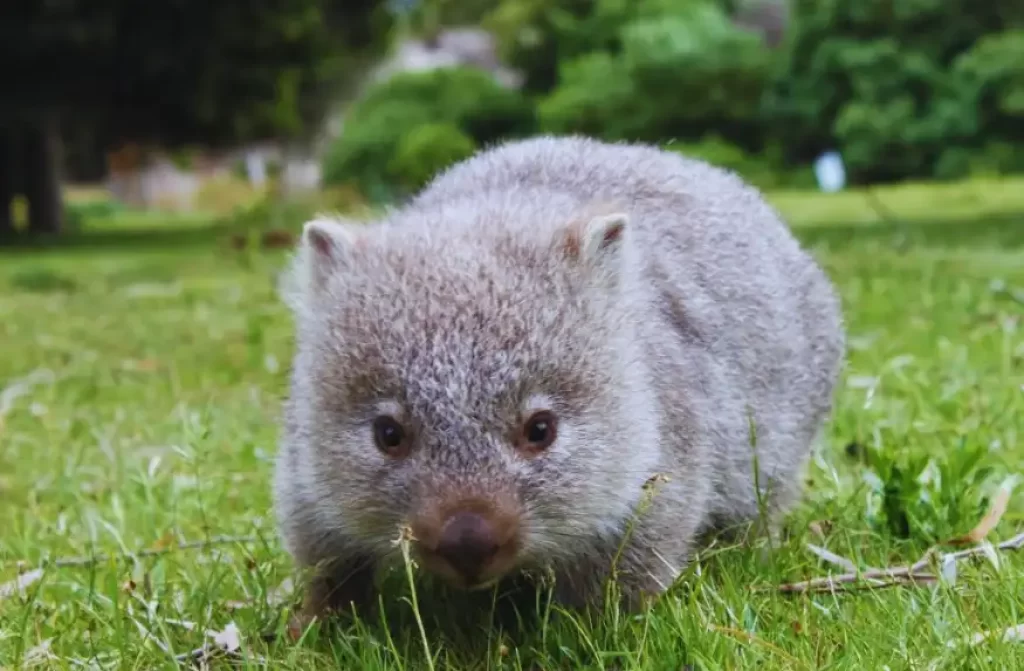
| Taxonomic Rank | Classification |
|---|---|
| Kingdom | Animalia |
| Phylum | Chordata |
| Class | Mammalia |
| Order | Diprotodontia |
| Family | Vombatidae |
| Genus | Vombatus |
| Species | V. ursinus |
Common Wombats and kangaroos may belong to different animal families, but they have some surprising similarities. Let’s take a closer look!
Firstly, both of these awesome creatures are marsupials. That means they have pouches to carry their babies. Wombats have pouches facing backward, which helps them keep the dirt out while they dig, while kangaroos have pouches facing forward to cradle their little ones as they hop around.
Now, when it comes to food, both wombats and kangaroos are herbivores. They love munching on plants like grass, roots, and bark. You can think of them as the veggie enthusiasts of the animal world!
Another cool thing is that they both have some pretty neat adaptations. Kangaroos are famous for their hopping skills, thanks to their powerful hind legs. On the other hand, wombats have super-strong legs too, but they use them for digging burrows. These burrows are like cozy underground homes where wombats can hide and sleep.
So, while wombats and kangaroos might be from different families, they share some incredible features like carrying their babies in pouches, being vegetarian foodies, and having awesome abilities suited to their habitats. They’re both unique and fascinating members of Australia’s animal kingdom!
21. Yellow-footed Wallaby
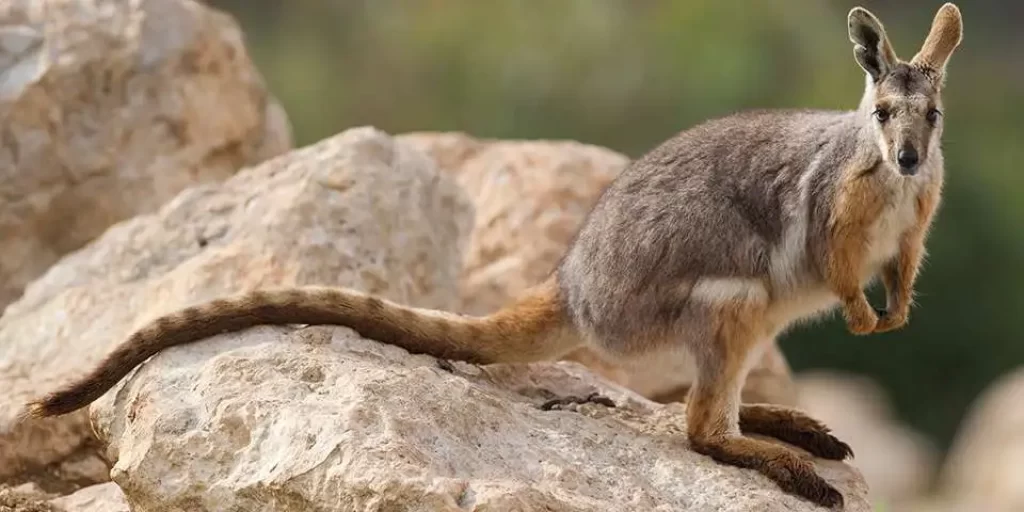
| Taxonomic Rank | Classification |
|---|---|
| Kingdom | Animalia |
| Phylum | Chordata |
| Class | Mammalia |
| Order | Diprotodontia |
| Family | Macropodidae |
| Genus | Macropus |
| Species | M. xanthopus |
The Yellow-footed Wallaby (Macropus fuliginosus), also known as the Black-footed Rock-wallaby, is a remarkable marsupial species native to Australia. While it is not closely related to kangaroos, it does share some similarities with them.
Firstly, the Yellow-footed Wallaby belongs to the same family as kangaroos, Macropodidae. This family includes a diverse range of marsupials, including kangaroos, wallabies, and wallaroos. Although they may not be direct relatives, they are part of the same larger family tree.
In terms of appearance, the Yellow-footed Wallaby exhibits certain characteristics reminiscent of kangaroos. It has long, powerful hind legs and large feet, which enable it to move with agility and efficiency. Like kangaroos, it also has a distinctive, muscular tail that aids in balance and mobility.
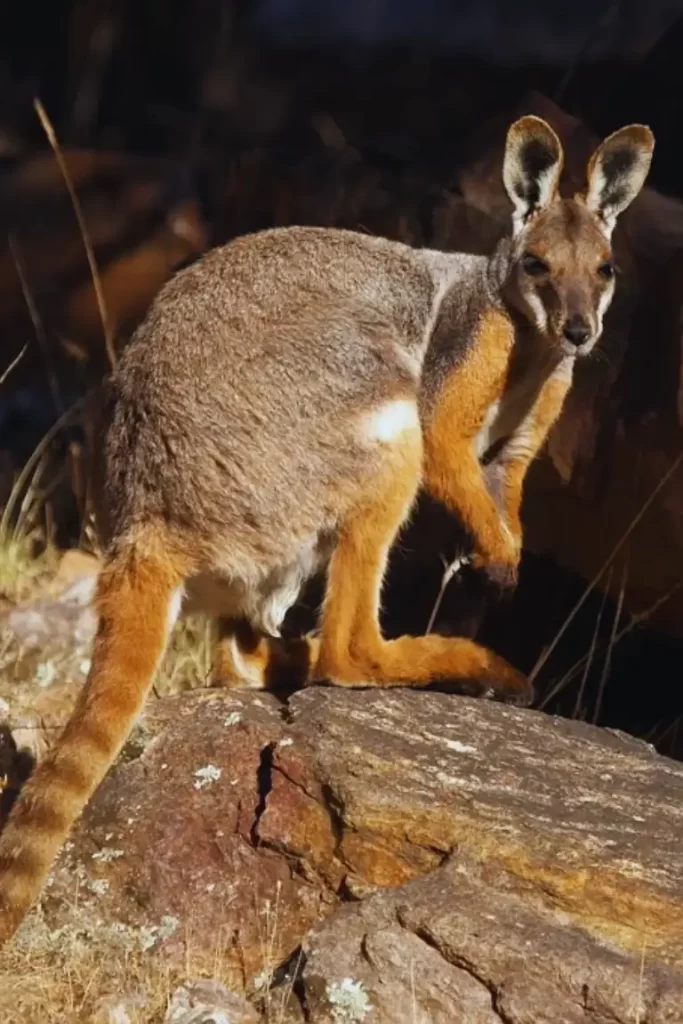
Furthermore, both the Yellow-footed Wallaby and kangaroos are herbivorous, primarily feeding on grasses, leaves, and other vegetation. This shared dietary preference reflects their adaptation to similar ecological niches within the Australian landscape.
However, it’s important to note that there are also notable differences between Yellow-footed Wallabies and kangaroos.
The Yellow-footed Wallaby is a smaller species, typically reaching about 60-70 centimeters (24-28 inches) in length, while kangaroos can grow much larger. Additionally, their specific behaviors, habitats, and social structures may differ.
22. Tiger Quolls
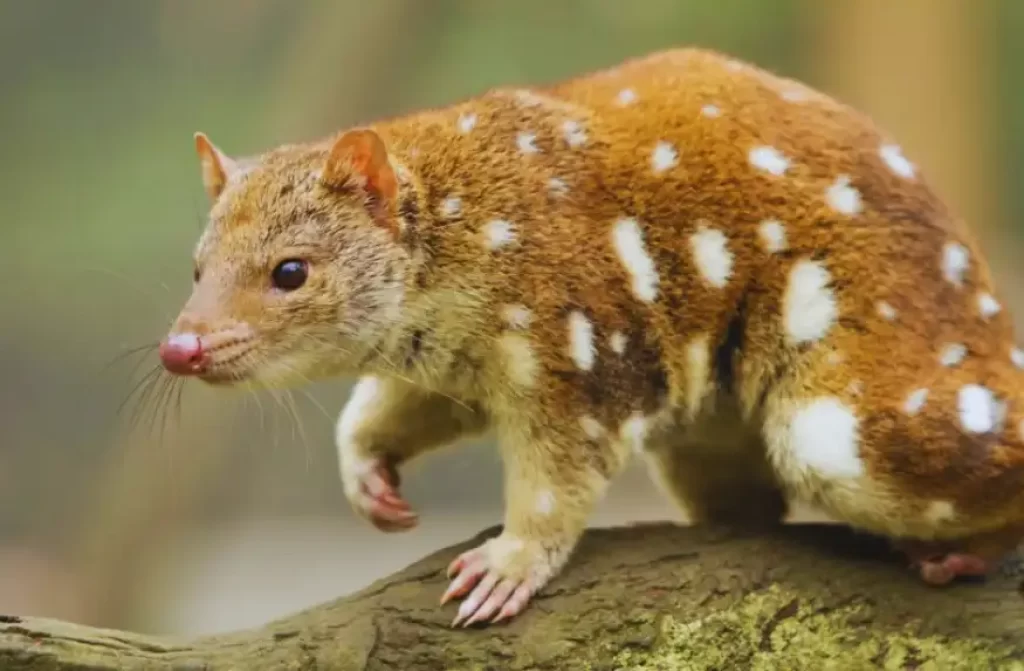
The Tiger Quoll (Dasyurus maculatus), also known as the Spotted-tail Quoll, is a fascinating marsupial native to Australia. While it is not closely related to kangaroos, the Tiger Quoll shares some interesting similarities with these iconic Australian animals. Let’s delve into the unique characteristics of the Tiger Quoll and its connections to kangaroos.
| Taxonomic Rank | Classification |
|---|---|
| Kingdom | Animalia |
| Phylum | Chordata |
| Class | Mammalia |
| Order | Dasyuromorphia |
| Family | Dasyuridae |
| Genus | Dasyurus |
| Species | D. maculatus |
The Tiger Quoll belongs to the family Dasyuridae, which also includes other carnivorous marsupials like quolls and the Tasmanian devil. Found in various habitats across eastern and southeastern Australia, the Tiger Quoll adapts to a range of environments, including forests, woodlands, and grasslands.
Similar to kangaroos, the Tiger Quoll exhibits sexual dimorphism, with males being larger than females. The species has a distinctive appearance, with a stocky body, short legs, and a long, bushy tail. Its coat is adorned with beautiful spots or stripes, varying in color from reddish-brown to black. These markings evoke patterns seen on certain kangaroo species.
Like kangaroos, the Tiger Quoll is primarily a nocturnal creature. It spends its days resting in dens or tree hollows and becomes active during the night. This adaptation allows it to avoid the heat of the day and take advantage of the cover of darkness for hunting and exploring its surroundings.
While kangaroos are herbivores, the Tiger Quoll is a carnivorous marsupial. It preys upon a wide range of small to medium-sized animals, including birds, reptiles, insects, and small mammals. This shared aspect of being a predator highlights the diverse feeding strategies within the marsupial lineage.
23. Koalas
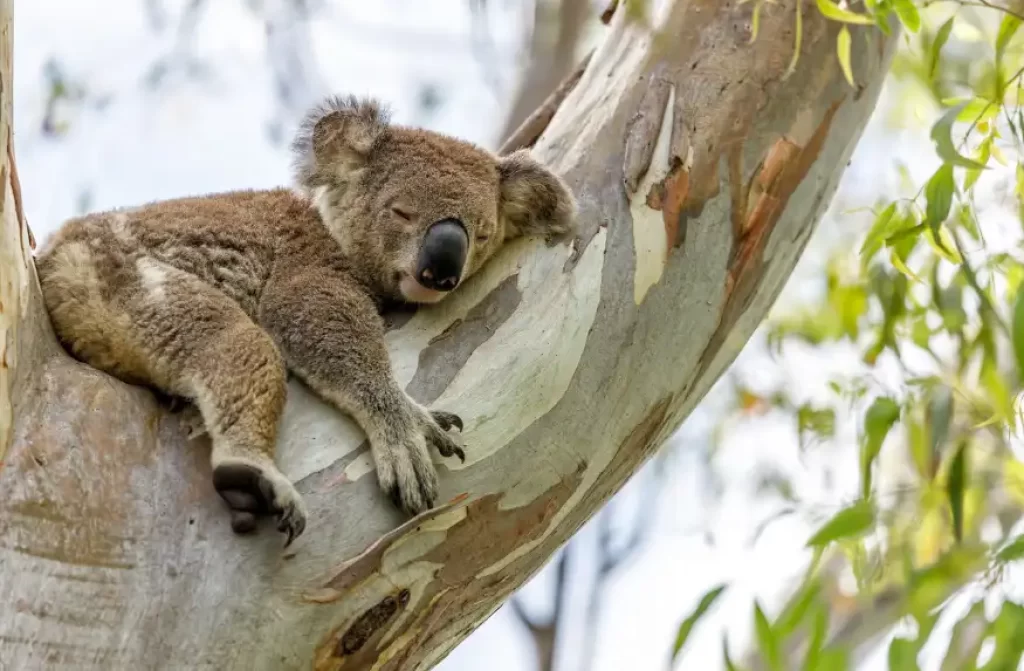
| Taxonomic Rank | Classification |
|---|---|
| Kingdom | Animalia |
| Phylum | Chordata |
| Class | Mammalia |
| Order | Diprotodontia |
| Family | Phascolarctidae |
| Genus | Phascolarctos |
| Species | P. cinereus |
Koalas (Phascolarctos cinereus) belong to the family Phascolarctidae and are native to the eastern and southeastern regions of Australia. They primarily inhabit eucalyptus forests, where they find their main source of food and shelter.
Koalas possess a distinct appearance with round faces, large round ears, and a stout, bear-like body. Their soft, dense fur ranges in color from silver-gray to brown, enabling them to blend seamlessly into the eucalyptus trees they call home.
Adapted for an arboreal lifestyle, koalas have strong limbs, sharp claws, and specialized grasping hands and feet, allowing them to cling effortlessly to branches and navigate their tree-dwelling habitat.
While kangaroos are known for their herbivorous diets, koalas share a similar preference for vegetation. Eucalyptus leaves form the majority of their diet, providing both nutrition and hydration. Koalas have developed specialized adaptations to digest the tough and toxic compounds found in eucalyptus leaves, making them highly specialized herbivores.
Like kangaroos, koalas are marsupials and possess a pouch. However, there are notable differences between their pouches. Female kangaroos have front-facing pouches, while female koalas have backward-facing pouches. Nonetheless, the concept of nurturing and protecting their young within the safety of a pouch is a shared trait among marsupials, including these two iconic species.
Nocturnal and Low-Energy Lifestyle
Both koalas and kangaroos have adapted to conserve energy and avoid extreme temperatures. Koalas, like kangaroos, are primarily nocturnal, spending most of their days sleeping or resting in the branches of eucalyptus trees. This behavior allows them to conserve energy and minimize water loss during the hotter parts of the day.
Although koalas are not closely related to kangaroos, they share some intriguing similarities, including herbivorous diets, arboreal adaptations, pouch-bearing nature, and a preference for nocturnal activity.
Conclusion
While numerous animals may bear similarities to kangaroos, such as the Spring Hare and Yellow-footed Wallaby, it is essential to recognize that these resemblances often lie in certain physical traits or shared behaviors rather than direct evolutionary relationships.
Each of these animals has its own distinct characteristics, adaptations, and ecological roles that make them fascinating in their own right.
Exploring the diverse array of animals similar to kangaroos provides us with a deeper appreciation for the remarkable biodiversity found in Australia and other parts of the world.
From marsupials with unique pouches and herbivorous diets to those with specialized locomotion or climatic adaptations, each species contributes to our planet’s intricate tapestry of life.







